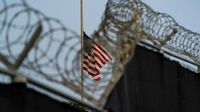On September 2, 2025, a chartered Boeing 767 touched down at Havana’s José Martí International Airport, carrying 161 Cuban deportees—the largest single deportation flight of its kind in history, according to CNN. As the passengers descended the aircraft’s steps, the marks of their journey were visible in more ways than one: shackles were removed from wrists and ankles, and the faces of many betrayed confusion, exhaustion, and heartbreak. For some, it was the first time in years they had set foot on Cuban soil. For others, it marked a painful return to a country they had risked everything to leave.
This historic flight was not just a logistical milestone; it signaled a decisive shift in U.S. immigration policy toward Cubans, undoing decades of preferential treatment that began in the aftermath of Fidel Castro’s rise to power. For generations, Cubans fleeing the island were welcomed as political refugees, with both Democratic and Republican administrations granting them a unique fast track to permanent residency in the United States. That era, it seems, is drawing to a close.
Lieutenant Colonel Lurdes Gil Robaina, a Cuban immigration official, told CNN, “They are Cubans. They are returning home, to where their families are. They have no immigration problems to reintegrate them into society.” Yet the reality for many is far more complicated. The policy shift means that tens of thousands of Cubans who arrived in the U.S. during President Biden’s tenure—hoping to benefit from the longstanding asylum tradition—now face deportation and the prospect of wrenching family separations.
The human toll of these policy changes is palpable. Tania Carbonell Cruz, one of the deportees, left behind three adult children in Texas, all of whom managed to secure residency because they arrived earlier than she did. “I have mixed feelings,” Carbonell Cruz told CNN. “My children are there, and my husband is here.” After more than three years in the U.S., she agreed to deportation rather than endure prolonged detention, but the cost was a divided family.
Stories like hers are becoming increasingly common as U.S. immigration enforcement intensifies. Many deportees recounted experiences of inadequate treatment by ICE officers, including tight handcuffs that left marks and extended stays in isolation centers. The emotional scars of these encounters are often compounded by the uncertainty awaiting them back in Cuba, where they must rebuild their lives from scratch.
For some, the trauma of separation is even more acute. Yudierquis Reyes Merino, another deportee, was returned to Cuba without her two-year-old daughter. Reyes had crossed into the U.S. from Mexico in 2022 and was working in Nebraska when she was detained by ICE during a routine check-in. She had pleaded no contest to a second-degree assault charge in 2023 and was sentenced to probation. After weeks in detention, Reyes agreed to deportation on the condition that she could bring her daughter with her. Instead, ICE officials placed her on the plane alone, telling her that her daughter, as a U.S. citizen, could not leave the country.
“They left behind my two-year-old daughter. I lost her,” Reyes sobbed upon arrival in Havana. Her story, reported by CNN, underscores the complex interplay of U.S. immigration law, parental rights, and the best interests of children caught in the crossfire. The Department of Homeland Security described Reyes as a “criminal illegal alien” and stated the child would remain in the U.S. at her father’s request. However, a CNN review of court records found no conviction for child abuse, as initially claimed by DHS. The girl’s father, Miguel Camacho, told CNN he was a U.S. resident, not a citizen, and that he believed life in Cuba would be too hard for his daughter.
The Trump administration’s approach to immigration has been marked by aggressive enforcement and sweeping policy changes. In January 2025, the administration dramatically expanded the use of expedited removals—so-called “fast-track deportations”—to include a much broader swath of immigrants living in the U.S. without legal status. Previously, such removals were limited to individuals caught near the border within two weeks of entry. Under the new policy, millions could potentially be removed from the country without a court hearing.
This expansion faced a major legal setback on September 2, when U.S. District Judge Jia Cobb ruled that the administration could not deport people without a court hearing, pausing the use of expedited removals. Judge Cobb, a Biden appointee, criticized the administration for acting recklessly and violating due process rights, warning that such actions could even threaten the rights of American citizens. “Were that right, not only noncitizens, but everyone would be at risk,” Cobb wrote in her ruling. “The Government could accuse you of entering unlawfully, relegate you to a bare-bones proceeding where it would ‘prove’ your unlawful entry, and then immediately remove you.”
The Department of Homeland Security was quick to defend the administration’s authority. “President Trump has a mandate to arrest and deport the worst of the worst,” DHS said in a statement, emphasizing a focus on individuals with criminal convictions and a goal of deporting one million people annually. The administration’s efforts have been backed by a massive federal spending bill, which allocated roughly $170 billion for immigration and border security in 2025. Of that, $75 billion went to ICE, including $45 billion to expand detention capacity and $30 billion for deportation processes.
Yet the legal landscape remains unsettled. Judge Cobb’s ruling did not challenge the constitutionality of expedited removal itself, only the rapid and wide-reaching expansion without adequate due process. Legal experts, such as Notre Dame professor Erin Corcoran, noted that if the courts continue to uphold due process concerns, the administration may have to devise alternative processes outside the traditional immigration court system. “If there’s some kind of process and the government can make a reasonable argument that that’s sufficient process, the courts have actually been pretty deferential in that context. Due process is kind of squishy, at least for procedural due process,” Corcoran told TNND.
Meanwhile, the political and humanitarian dynamics between Washington and Havana remain as fraught as ever. Cuban officials have signaled reluctance to accept tens of thousands of returnees, fearing the social and economic consequences of mass forced returns. Alejandro Garcia del Toro, a Cuban Foreign Ministry official, told CNN, “The issue is the US law – the decision by the US government in the 1960s to use the immigration factor as a political weapon against the Cuban revolution has now created this reality. For decades the policy was to incite, to urge Cubans to abandon their country. All of a sudden, the US has changed the whole policy.”
For deportees like Yudierquis Reyes, the damage is already done. Living with relatives in central Cuba, she struggles to reconnect with her daughter by video call, the child unable to recognize her mother’s voice. Despite the dangers she faced on her journey to the U.S.—crossing the Darien Gap, evading kidnappers, and riding atop Mexico’s notorious “train of death”—Reyes remains determined to be reunited with her daughter. “Donald Trump only has three years left, I have the rest of my life,” she said. “I will go and get her. I don’t care if they give me 20 years in jail.”
As the U.S. government continues to recalibrate its immigration policies, the stories of those caught in the middle offer a sobering reminder of the human cost behind the headlines and the enduring impact of decisions made in Washington and Havana alike.





